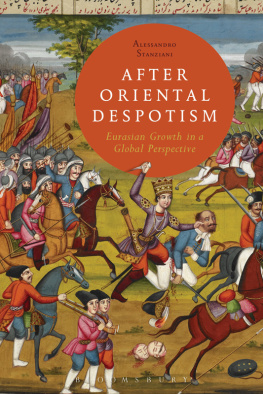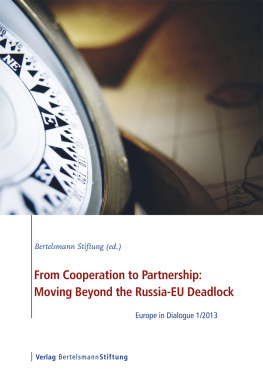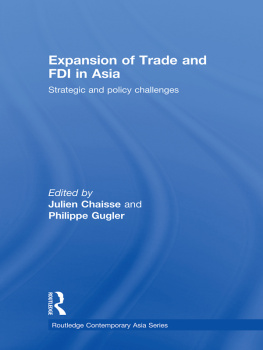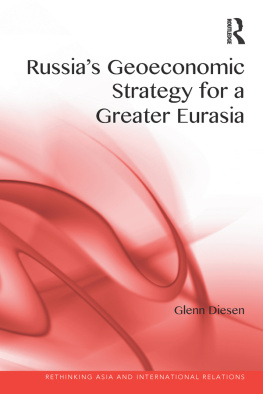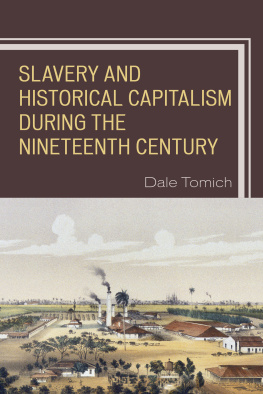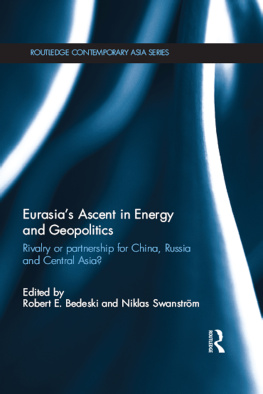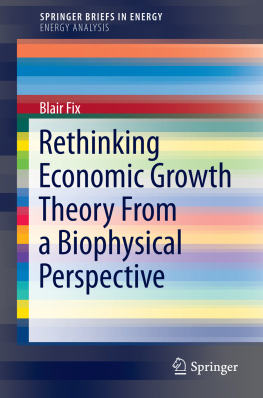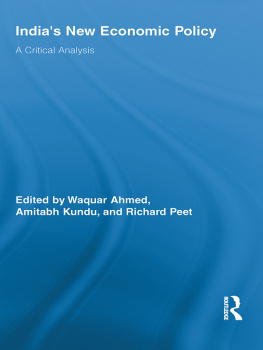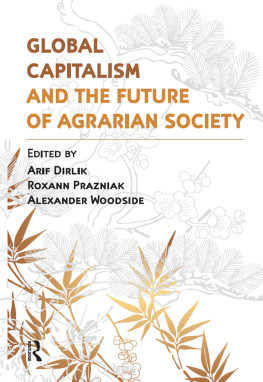After Oriental Despotism
After Oriental Despotism
Eurasian Growth in a Global Perspective
Alessandro Stanziani

Contents
French CNRS (Centre National de la Rechecher Scientifique) and the French ANR (Agence Nationale de la Recherche) provided funds and grants to successfully complete this research.
This book has benefited from the support of many friends and colleagues. Jeremy Black immediately supported this book; in Paris, at the EHESS, Maurice Aymard, Gilles Postel-Vinay and Christian Lamouroux discussed at length several chapters; I also benefited from discussions with my students.
Jane Burbank (NYU) and Fred Cooper (NYU) discussed over years parts, papers and seminars linked to this book. Marcel van der Linden (IISG) always encouraged my work.
Prabhu Mohapatra (Delhi University) and Madhavan Palat as well as the participants in the biannual meeting of Indian Labour Historians commented on earlier drafts.
Elise Kimerling Wirtschafter (Pomona University) made comments on earlier drafts, seminars and, finally, on the whole manuscript. I fully acknowledge my debt to her valuable suggestions and comments.
Marina Mogilner and Ilia Guerasimov friends of Ab Imperio, in Kazan, and who have just recently moved to the University of Illinois made valuable comments at the workshop they organized in Kazan.
In Japan, I had the opportunity to present and discuss chapters of this book with Kimitaka Matsusato (Sapporo University), Kaoru Sugihara (Tokyo University) and Masashi Haneda (Tokyo University). Professor Takeo Suzuki discussed with me and organized several lectures and seminars at the Waseda University. Faculty and students helped me with extremely valuable comments.
Other friends in the USA also helped me with comments and suggestions: Brian Davis (UTSA), R. Bin Wong (UCLA), David W. Sabean (UCLA), and Kenneth Pomeranz (University of Chicago). Richard Roberts and the Stanford University provided me with a one-month invitation. Lectures at Stanford largely contributed to complete this book.
In Berlin, the Wissenschafts Kolleg provided a wonderful intellectual environment and the opportunity to discuss my work in several German universities. Andreas Eckert and Jurgen Kocka, at Re-Work (Humboldt University), debated my work at length.
In Russia, Boris Ananich and the archive personnel in both Moscow and Petersburg helped with the files, permissions and research. I strongly regret that my former mentor and friend in Russia, Viktor Petrovich Danilov, one of the greatest historians of his generation, left us before I could achieve this book.
Russia maintained its power, with ups and downs, for centuries, despite repeated European forecasts of its imminent fall. During the reign of Peter the Great and after the Crimean War (18531856), the Bolshevik revolution in 1917, the putsch in 1989 and the financial crisis in 1997, the West always believed it could see signs of Russias impending collapse, but it never occurred. What accounts for this and how can we possibly explain such a discrepancy between Western expectations and Russian performance?
From the eighteenth century to the present, comparisons between Russia and the major European countries have formed part of a wider debate about backwardness. The goal has been to create a comparative scale to account for both economic growth and so-called blockages. Montesquieus Asiatic Despotism, Voltaires and Diderots perceptions of Russia and Asia, and the so-called Asiatic mode of production described by liberal, radical and Marxist historiography in the nineteenth century are well-known examples. Then, in the twentieth century, the comparative and global analysis of Eurasia found its way into discussions of backwardness and underdevelopment, decolonization, the fate of communism and the Cold War as well as arguments such as Oriental despotism and Hayeks Road to Serfdom . Authors as different as Kula, Wallerstein and North agree on this: in early modern times, Russia and Eastern Europe responded to the commercial, agrarian and then industrial expansion of the West by binding the peasantries to the land and its lords. The connections between Europe and Asia exclude Central Eurasia. What if we were to abandon both classical oppositions and the more recent ranking of Europe and Asia and question regional and global history through the lens of Central Eurasia?
In this book I will focus on the Russian case not to confirm our preconceptions but to disclose historical possibilities, bifurcations and ultimately a new vision of modernization. Economic backwardness, Asiatic despotism, Orientalism and dependence express our perceptions of modernization over the last three centuries. Those perceptions include the identification and fear of the Asiatic, Mongol, then communist and now, once again, yellow and new Russian mafia perils. After the collapse of the Berlin Wall and Asias return to world prominence, after the global crisis of the Western economies, the time has come to discuss these notions and stop using history to judge or to prove the superiority of the West in terms of economic efficiency or political organization. Instead, I wish to provide a new view of Eurasian history and from that starting point, re-examine global history and modernization.
My primary aim is to avoid comparing the Russian and Inner Asian case exclusively to an ideal model of the West. I want to reconcile the differences between the historical paths specific to particular regions with their interconnections, transfers and overall dynamics. In the following pages, after a preliminary discussion (slaves, bonded people and war captives in Russia and Central Asia between the fifteenth and the nineteenth centuries. We will identify the three main areas and routes of the slave trade: the Silk Road, Central Asia and the Mediterranean; the trade of goods and slaves between Russia, Central Asia, Iran and India; the slave trade between Russia, the Crimean Khanate and the Ottoman Empire.
This innovative study of the slave trade in Eurasia has important implications for the interpretation of Russian history on the one hand, and for the global history of slavery and trade on the other. Without the Eurasian slave trade, Mediterranean and later transatlantic slavery would have been radically different. The Eurasian slave trade provided people, models and practices of enslavement to the expanding West. Thus, instead of a break between the slavery of the ancient world and colonial slavery, I will assert a continuity through the Middle Ages and early modern times on a Eurasian and then a global scale.
It would be a mistake, however, to follow this history only in the new connections between Afro-Eurasia and the Atlantic. The heritage of Eurasian slavery and state expansion was important in Russia and Inner Asia as well. New connections appeared between slavery and other forms of bondage, namely serfdom. Discussions of Russian serfdom have adopted a much more cautious attitude; they have mostly focused on its origin (the State role of intermediary institutions (bailiffs and village elders) and their ability to complement each other. From there, we will show that Russian local markets were increasingly incorporated into a national market during the second half of the eighteenth century; not only landlords but also their peasants firmly entered the rural agrarian markets. Peasants activity on rural markets surpassed that of merchants and small urban traders.
This conclusion implies that there is no evidence for Kulas and Wallersteins models. According to them, under second serfdom, Russian demesnes reduced their integration in local markets, peasants became self-sufficient and landlords extracted a surplus of grain from the peasants and then sold it mostly abroad and used the income not to invest, but only to buy luxury products. In this view, Russian and Eastern European serfdom constituted the quasi-periphery of Europe. We contest this view and show there was significant market and economic development in Russia itself in the eighteenth and early nineteenth centuries.
Next page
